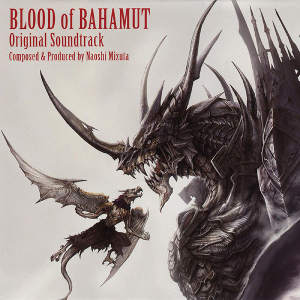Blood of Bahamut Original Soundtrack
 |
Album Title: Blood of Bahamut Original Soundtrack |
| Record Label: Square Enix |
|
| Catalog No.: SQEX-10166 |
|
| Release Date: June 24, 2009 |
|
| Purchase: Buy at CDJapan |
Overview
With the discontinuation of Final Fantasy XI expansions, Naoshi Mizuta finally became liberated to work on new projects. In 2009, he actually shuffled four projects all at once, namely the Final Fantasy XI expansion chapters, the arranged album Sanctuary, the spinoff Final Fantasy Gaiden, and the original DS RPG Blood of Bahamut. Blood of Bahamut featured a mission-based system where multiplayer gamers would battle giant beats. In order to fit the scenario, Mizuta chose to experiment with an orchestral focus, but still kept true to his ostinato-based musicality. The resultant score certainly worked in the game and is listenable on a stand-alone basis, but lacks in terms of creativity and stimulation.
Body
Following a few opening brass fanfares, the composition leaps into a militaristic march featuring commanding brass melodies, bombastic string bass, and Mizuta’s trademark woodwind flourishes. The theme is decently developed and harmonised, while exhibiting a sufficiently memorable and emotional melody. Yasuhiro Yamanaka’s samples go some way to emulating the sound of an orchestra using the DS and are refreshingly free of the buzzing that hinders many of the console’s soundtracks. However, their inevitable memory restrictions mean they’re still a far way off sounding wholesome or expressing humanity. That said, the remastered version at the end of the soundtrack — as previously featured as website background music — has quite a bit more substance than the opening version. The softer reprise of the theme in the end credits theme “To Trusted Friends” is also well done. In an otherwise bombastic soundtrack, this piece stands out as the one likely to create a personal bond with the gamers.
Beyond the exceptional main theme, much of the soundtrack exhibits the musicality most have come to expect from Mizuta. “A Steady Beast” immediately recounts his ostinato-based approach to underwhelming effect. Most of the composition features an atmospheric yet underdeveloped melody being paassed from strings to woodwinds. Composed of a repeating harp figure and some snare rolls, the accompaniment fails to bring much to the picture and technically isn’t really harmony at all. Whereas Mizuta has been famed for his development in the past, many of the pieces here disappoint in this regard on Blood of Bahamut. “The Behemoth Awakens”, “A Free Journey”, and “A Free Journey” are just a few that sound initially promising, but end up repeating themselves within 30 seconds. Other pieces feature various bridges and development sections, but they feel more obligatory than natural. Such music can suffice for background listening, but is hardly inspiring from a CD player.
Nevertheless, most compositions have some charm and the action themes are particularly likeable. Tracks like “Time to Counterattack”, “An Offensive”, and “The Two Heroes” are reminiscent of Mizuta’s Final Fantasy XI battle themes. They’re pretty formulaic — comprising brisk string ostinati, compelling wind leads, and deep secondary sections — but have enough drive and drama to be worthwhile. That said, some of the melodic and chord progressions are so cheesy that they disturb the natural flow of the music. Others such as “Feral Ifrit”, “A Reckless Battle”, and “The Godly Overseer of Puragatory” gradually develop to create quite foreboding timbres dominated by orchestra, chorus, and chorus; the former, in fact, almost sounds like a condensed version of “Castle Zvahl”. Yet others such as “The Behemoth of the Assassin’s Blade” and “The Behemoth Gigant” reinforce the militaristic feel of the game as rousing war marches. Yet ahile all the themes sound pretty good in context and on the album, they seem to often lack in terms of originality and few deviate from the conventions of Mizuta’s past works.
Arguably Mizuta’s greatest strength is depicting scenery and he demonstrates it to some extent here despite the dominance of action themes. His contributions tend to be more ambient than those of Final Fantasy XI, but not as samey as those on Parasite Eve II. Most notably, “The Scorched Land” makes a big impact with its offbeat rhythms and blistering buildups while “The Ice Queen” is so beautifully soundscaped that it is a perfect complement of the scene. Others such as “Ancient Memories” feature occasionally beautiful moments, yet develop in such an uninspired way that they don’t sustain interest. Nevertheless, Mizuta does occasionally channel original inspirations. For example, “Legend” and “Embers of Life” are some of the most cinematic compositions he has done — the former reminiscent of Sakimoto’s Final Fantasy XII work — while “Someone to Protect” and “Promise” are more Mitsuda-inspired with their sentimental organic flavours. Yet while these are competent imitations, they are also pale ones, much in common with the rest of the soundtrack.
Summary
Naoshi Mizuta created essentially a competent and effective work in Blood of Bahamut despite being an amateur orchestral composer. Most themes are bound to fit their contexts well, whether orchestral overtures, subdued ambience, or blistering action themes. In addition, the majority is enjoyable on a stand-alone level due to decent melodies and various flashes of colour, or at the very least serves as inoffensive background music. What it lacks is a unique selling point. While Square Enix executives have stated the music intended to emulate the old-school style of game music, classics like Bahamut Lagoon did a more interesting job. Likewise the album doesn’t stand up among the more recent orchestral soundtracks given both its naive orchestrations and limited sound quality. Nevertheless, those who enjoyed the game or like collecting soundtracks probably won’t go too wrong by buying it. There’s just not that much incentive to.
Do you agree with the review and score? Let us know in the comments below!
3
Posted on August 1, 2012 by Chris Greening. Last modified on January 23, 2016.














